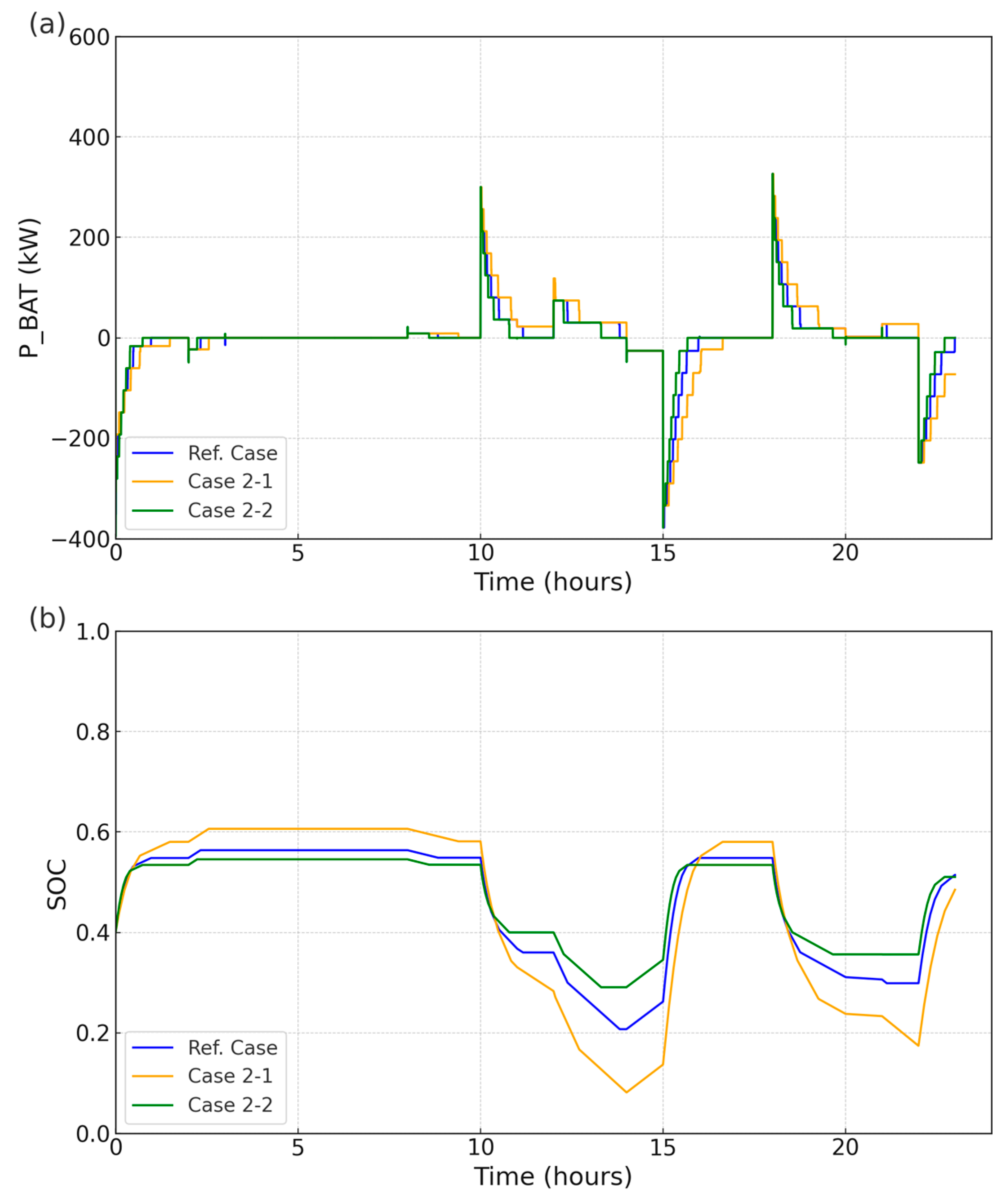Energy Management Strategies for Hybrid Propulsion Ferry with Different Battery System Capacities
Abstract
1. Introduction
2. Model Description
2.1. Target Ship: Hybrid Propulsion Ferry
2.2. Proton-Exchange Membrane Fuel Cell (PEMFC)
2.3. Lithium-Ion Battery
3. Energy Management Algorithm
4. Results and Discussion
5. Conclusions
Author Contributions
Funding
Institutional Review Board Statement
Informed Consent Statement
Data Availability Statement
Conflicts of Interest
Nomenclature
| maximum C-rate | |
| energy capacity of battery | |
| Nernst voltage | |
| mass flow rate of hydrogen | |
| equivalent mass flow rate of hydrogen for battery | |
| power coefficient for SOC | |
| output power of battery | |
| output power of PEMFC | |
| maximum output power of PEMFC | |
| minimum output power of PEMFC | |
| required propulsion power of ship | |
| state of charge | |
| maximum value of state of charge | |
| minimum value of state of charge | |
| reference value of state of charge | |
| operation time | |
| cell voltage of PEMFC | |
| activation loss | |
| concentration loss | |
| potential energy output of PEMFC | |
| ohmic loss | |
| equivalence factor | |
| Abbreviations | |
| ECMS | equivalent consumption minimization strategy |
| EMS | energy management strategy |
| IMO | International Maritime Organization |
| MEPC | Maritime Environment Protection Organization |
| PEMFC | proton-exchange membrane fuel cell |
| SOC | state of charge |
| SQP | sequential quadratic programming |
References
- IMO. 2023 IMO Strategy on Reduction of GHG Emissions from Ships; IMO: London, UK, 2023. [Google Scholar]
- Jung, W.; Choi, M.; Jeong, J.; Lee, J.; Chang, D. Design and analysis of liquid hydrogen-fueled hybrid ship propulsion system with dynamic simulation. Int. J. Hydrogen Energy 2024, 50, 951–967. [Google Scholar] [CrossRef]
- Jung, W.; Lee, J.; Chang, D. Heat Integration of Liquid Hydrogen-Fueled Hybrid Electric Ship Propulsion System. J. Mar. Sci. Eng. 2023, 11, 2157. [Google Scholar] [CrossRef]
- Lee, H.; Ryu, B.; Anh, D.P.; Roh, G.; Lee, S.; Kang, H. Thermodynamic analysis and assessment of novel ORC-DEC integrated PEMFC system for liquid hydrogen fueled ship application. Int. J. Hydrogen Energy 2023, 48, 3135–3153. [Google Scholar] [CrossRef]
- Shakeri, N.; Zadeh, M.; Nielsen, J.B. Hydrogen fuel cells for ship electric propulsion: Moving toward greener ships. IEEE Electrif. Mag. 2020, 8, 27–43. [Google Scholar] [CrossRef]
- Ye, M.; Sharp, P.; Brandon, N.; Kucernak, A. System-level comparison of ammonia, compressed and liquid hydrogen as fuels for polymer electrolyte fuel cell powered shipping. Int. J. Hydrogen Energy 2022, 47, 8565–8584. [Google Scholar] [CrossRef]
- Jung, W.; Chang, D. Deep Reinforcement Learning-Based Energy Management for Liquid Hydrogen-Fueled Hybrid Electric Ship Propulsion System. J. Mar. Sci. Eng. 2023, 11, 2007. [Google Scholar] [CrossRef]
- Antonopoulos, S.; Visser, K.; Kalikatzarakis, M.; Reppa, V. MPC framework for the energy management of hybrid ships with an energy storage system. J. Mar. Sci. Eng. 2021, 9, 993. [Google Scholar] [CrossRef]
- Bassam, A.M.; Phillips, A.B.; Turnock, S.R.; Wilson, P.A. Development of a multi-scheme energy management strategy for a hybrid fuel cell driven passenger ship. Int. J. Hydrogen Energy 2017, 42, 623–635. [Google Scholar] [CrossRef]
- Kalikatzarakis, M.; Geertsma, R.; Boonen, E.; Visser, K.; Negenborn, R. Ship energy management for hybrid propulsion and power supply with shore charging. Control Eng. Pract. 2018, 76, 133–154. [Google Scholar] [CrossRef]
- Lee, H.; Cha, S.W. Reinforcement Learning Based on Equivalent Consumption Minimization Strategy for Optimal Control of Hybrid Electric Vehicles. IEEE Access 2021, 9, 860–871. [Google Scholar] [CrossRef]
- Deng, K.; Liu, Y.; Hai, D.; Peng, H.; Löwenstein, L.; Pischinger, S.; Hameyer, K. Deep Reinforcement Learning Based Energy Management Strategy of Fuel Cell Hybrid Railway Vehicles Considering Fuel Cell Aging. Energy Convers. Manag. 2022, 251, 115030. [Google Scholar] [CrossRef]
- Letafat, A.; Rafiei, M.; Ardeshiri, M.; Sheikh, M.; Banaei, M.; Boudjadar, J.; Khooban, M.H. An Efficient and Cost-Effective Power Scheduling in Zero-Emission Ferry Ships. Complexity 2020, 2020, 6487873. [Google Scholar] [CrossRef]
- Tang, Y.; Yuan, W.; Pan, M.; Li, Z.; Chen, G.; Li, Y. Experimental investigation of dynamic performance and transient responses of a kW-class PEM fuel cell stack under various load changes. Appl. Energy 2010, 87, 1410–1417. [Google Scholar] [CrossRef]
- Alaswad, A.; Omran, A.; Sodre, J.R.; Wilberforce, T.; Pignatelli, G.; Dassisti, M.; Baroutaji, A.; Olabi, A.G. Technical and commercial challenges of proton-exchange membrane (PEM) fuel cells. Energies 2020, 14, 144. [Google Scholar] [CrossRef]
- Hwang, S.; Lee, C.; Ryu, J.; Lim, J.; Chung, S.; Park, S. Optimal EMS Design for a 4-MW-Class Hydrogen Tugboat: A Comparative Analysis Using DP-Based Performance Evaluation. Energies 2024, 17, 3146. [Google Scholar] [CrossRef]
- He, H.; Xiong, R.; Fan, J. Evaluation of lithium-ion battery equivalent circuit models for state of charge estimation by an experimental approach. Energies 2011, 4, 582–598. [Google Scholar] [CrossRef]
- Hu, X.; Li, S.; Peng, H. A comparative study of equivalent circuit models for Li-ion batteries. J. Power Sources 2012, 198, 359–367. [Google Scholar] [CrossRef]
- Huria, T.; Ceraolo, M.; Gazzarri, J.; Jackey, R. High fidelity electrical model with thermal dependence for characterization and simulation of high power lithium battery cells. In Proceedings of the 2012 IEEE International Electric Vehicle Conference, Greenville, SC, USA, 4–8 March 2012; IEEE: Piscataway, NJ, USA, 2012; pp. 1–8. [Google Scholar]
- Wang, X.; Li, Q.; Wang, T.; Han, Y.; Chen, W. Optimized energy management strategy based on sqp algorithm for pemfc hybrid locomotive. In Proceedings of the 2019 IEEE Transportation Electrification Conference and Expo, Asia-Pacific (ITEC Asia-Pacific), Seogwipo, Republic of Korea, 8–10 May 2019; IEEE: Piscataway, NJ, USA, 2019; pp. 1–5. [Google Scholar]
- Xue, Q.; Zhang, X.; Teng, T.; Zhang, J.; Feng, Z.; Lv, Q. A comprehensive review on classification, energy management strategy, and control algorithm for hybrid electric vehicles. Energies 2020, 13, 5355. [Google Scholar] [CrossRef]
- Sangwan, V.; Sharma, A.; Kumar, R.; Rathore, A.K. Equivalent circuit model parameters estimation of li-ion battery: C-rate, soc and temperature effects. In Proceedings of the 2016 IEEE International Conference on Power Electronics, Drives and Energy Systems (PEDES), Trivandrum, India, 14–17 December 2016; IEEE: Piscataway, NJ, USA, 2016; pp. 1–6. [Google Scholar]
- Saxena, S.; Xing, Y.; Kwon, D.; Pecht, M. Accelerated degradation model for C-rate loading of lithium-ion batteries. Int. J. Electr. Power Energy Syst. 2019, 107, 438–445. [Google Scholar] [CrossRef]
- Wang, J.; Liu, P.; Hicks-Garner, J.; Sherman, E.; Soukiazian, S.; Verbrugge, M.; Tataria, H.; Musser, J.; Finamore, P. Cycle-life model for graphite-LiFePO4 cells. J. Power Sources 2011, 196, 3942–3948. [Google Scholar] [CrossRef]
- Guan, W.; Chen, L.; Wang, Z.; Chen, J.; Ye, Q.; Fan, H. A 500 kW hydrogen fuel cell-powered vessel: From concept to sailing. Int. J. Hydrogen Energy 2024, 89, 1466–1481. [Google Scholar] [CrossRef]




| Parameters | Value |
|---|---|
| Operation time () | 24 h |
| Minimum SOC () | 0.2 |
| Maximum SOC () | 0.8 |
| Reference SOC () | 0.5 |
| Minimum output of PEMFC () | 0 kW |
| Maximum output of PEMFC () | 520 kW |
| Equivalence factor () | 0.3, 0.5, 0.7 |
| Power coefficient for SOC () | 1 |
| Potential energy output of PEMFC () | 22.05 kWh/kg |
| Case Index | Energy Capacity of Battery System | Equivalence Factor |
|---|---|---|
| Ref. Case | 463 kWh | 0.5 |
| Case 1-1 | 347 kWh | 0.5 |
| Case 1-2 | 231 kWh | 0.5 |
| Case 1-3 | 116 kWh | 0.5 |
| Case 1-4 | 46 kWh | 0.5 |
| Case 2-1 | 463 kWh | 0.3 |
| Case 2-2 | 463 kWh | 0.7 |
| Simulation Case | Maximum C-rate |
|---|---|
| Ref. Case | 0.82 |
| Case 1-1 | 1.09 |
| Case 1-2 | 1.52 |
| Case 1-3 | 2.88 |
| Case 1-4 | 6.26 |
Disclaimer/Publisher’s Note: The statements, opinions and data contained in all publications are solely those of the individual author(s) and contributor(s) and not of MDPI and/or the editor(s). MDPI and/or the editor(s) disclaim responsibility for any injury to people or property resulting from any ideas, methods, instructions or products referred to in the content. |
© 2024 by the authors. Licensee MDPI, Basel, Switzerland. This article is an open access article distributed under the terms and conditions of the Creative Commons Attribution (CC BY) license (https://creativecommons.org/licenses/by/4.0/).
Share and Cite
Choi, M.; Choi, J.; Sung, D.; Jung, W. Energy Management Strategies for Hybrid Propulsion Ferry with Different Battery System Capacities. J. Mar. Sci. Eng. 2024, 12, 2165. https://doi.org/10.3390/jmse12122165
Choi M, Choi J, Sung D, Jung W. Energy Management Strategies for Hybrid Propulsion Ferry with Different Battery System Capacities. Journal of Marine Science and Engineering. 2024; 12(12):2165. https://doi.org/10.3390/jmse12122165
Chicago/Turabian StyleChoi, Minsoo, Jungho Choi, Dahye Sung, and Wongwan Jung. 2024. "Energy Management Strategies for Hybrid Propulsion Ferry with Different Battery System Capacities" Journal of Marine Science and Engineering 12, no. 12: 2165. https://doi.org/10.3390/jmse12122165
APA StyleChoi, M., Choi, J., Sung, D., & Jung, W. (2024). Energy Management Strategies for Hybrid Propulsion Ferry with Different Battery System Capacities. Journal of Marine Science and Engineering, 12(12), 2165. https://doi.org/10.3390/jmse12122165






